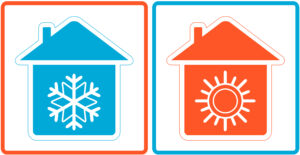
You may already know the big answer to this question: a heat pump operates like an air conditioner, except it can change the direction it moves heat so it can work as a heating system as well. This makes a heat pump an excellent two-in-one option for homeowners looking to change out their standard furnace/air conditioner combo.
But we plan to go deeper into the heat pump differences in this post. We’ll examine three parts in a heat pump that help it work as both a heating and cooling system. In most ways, a heat pump resembles an air conditioner, with two sets of refrigerant coils, a compressor, an expansion valve, an indoor blower fan, and an outdoor exhaust fan. The following three components are only in heat pumps and are critical for allowing them to work the way they do.
The Reversing Valve
This is the most important part that separates a heat pump from an air conditioner, because it allows the heat pump to change between heating and cooling modes. What the valve does is cause the direction refrigerant flows through the heat pump to reverse, and this causes the indoor and outdoor coil to switch jobs as the evaporator and the condenser.
Here’s how the valve works: refrigerant exits the compressor and then enters the valve. In cooling mode, the valve is set to direct the refrigerant toward the outdoor coil, where the hot refrigerant gas will lose heat and cool down before heading indoors. In heating mode, the valve directs the refrigerant toward the indoor coil, where it releases its heat inside and then cools down to move to the outdoor coil.
The Suction Line Accumulator
A heat pump uses less refrigerant when in heating mode. So where does the unused refrigerant go during this time? The suction line accumulator takes care of it. This suction line also handles another important job, which is to prevent slugging, the movement of cold refrigerant in the wrong direction into the compressor. Slugging can cause the compressor to fail, and it’s more likely to occur in a heat pump than an AC, so the suction line accumulator is vital protection against this.
The Crank-Case Heater
This is another defense against the dangers of slugging. This heater is mounted on top of the compressor to melt and evaporate any cold refrigerant that moves back into the compressor. When the cold refrigerant is heated, it then moves back out of the compressor.
We’ll Help With Your Heat Pump Repair Needs
If you have a heat pump that won’t do both parts of its job, it may mean that one of these components has failed. The reversing valve is the frequent culprit for when a heat pump won’t shift between its two modes. Failure of the other two parts can jeopardize the compressor—an expensive part to replace. If you notice any odd behavior from the compressor, such as strange noises or hard-starting, please call us right away for heat pump repair in Marrero, LA. Rescuing your compressor can mean rescuing your entire heat pump system.
Gowland’s Heating & A/C Values “Relationship over Revenue!” Call us whenever you need heat pump service in New Orleans and the surrounding areas.

